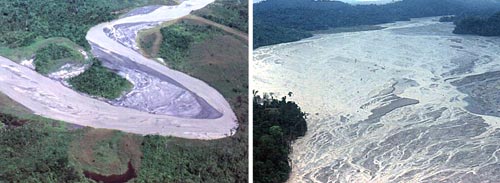Offshore Disposal - River, Lake and Sea discharge
Offshore Disposal - River, Lake and Sea discharge

Figure 1: River deposition, Jaba River, Bougainville Island, Papua New Guinea (Courtesy Geoff Pickup)
Offshore tailings disposal is the discharge of tailings to rivers, lakes and seas (figure 1). Submarine Tailings Disposal (STD) is perhaps the most common offshore disposal technique and involves the deep water discharge of tailings to the sea (Moore, Pelletier et al. 2002). Offshore disposal may be used where onshore techniques are either not possible due to terrain, high seismic activity, high rainfall and land availability (Coumans 2002). STD is mainly practiced at many mines in the Western Pacific region where these site factors are present and steep and unstable terrain creates high risks for developing conventional retaining structures.
River discharge creates vast environmental liabilities and costs associated with remediation and reclamation (Jakubick, McKenna et al. 2003). It has also generated substantial opposition that has contributed to the general negative public perception of the mining industry, thus harming its reputation.
One objective of offshore disposal is to place tailings where ambient dissolved oxygen levels are minimal to prevent oxidation and mobilisation of contaminants (Norman 1998). This type of tailings disposal technique also reduces engineering requirements and reduces or prevents the tailings storage footprint onshore (EC 2004). The major disadvantages to this storage method is the unpredictable nature of the tailings flows as they leave a discharge outlet, the unknown effects on subaqueous environments and the potential for contamination migration (EC 2004). No other tailings disposal method generates public concerns so quickly and intensely than offshore disposal (Vick 1990).
In certain situations tailings can be successfully discharged offshore with minimal environmental impact compared to conventional on-land methods, and with considerable cost saving. Even though offshore disposal may be damaging to a marine ecosystem it may prove to be the best option in a particular environment compared to the risks associated with onland disposal (MMSD 2002). Surface storage will have a permanent environmental impact and cost burden on maintenance, whereas offshore disposal may have a temporary environmental impact with no requirement of maintenance once mining activities have ceased. Tailings placed underwater do not have to resist erosion from post mining activities as they are placed in an environment that will eventually cover the tailings by land derived sediment and organic debris.
Ideally the tailings need to be deposited under the euphotic zone, which is the upper layer of a water body where photosynthesis and reproduction of marine plants occur, and below the surface mixed layer, which is the zone of turbulence caused by the wind and waves (MMSD 2002). A site survey will determine the depth to which these zones extend (normally >100m deep).
